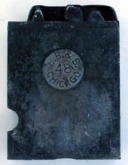Nicks are full or partial channels which appear on the front or the back of types (but on spacing material sometimes end up on the sides because spaces and quads may be used in various orientations). In America and England Nicks are almost always on the front of the type (see the Notebook on Naming the Parts of Types for a definition of front and back) . In continental Europe they are often on the back.
The purpose of the Nick is to aid the compositor. It allows the front (or back, in Europe) of the type to be distinguished easily by sight and feel. Within limits, it may also be used to distinguish fonts. There is no consistent system or pattern of meaning for the Nicks of types. Generally, though, a particular font will have been cast with the same Nick(s), and this may be useful to quickly distinguish a wrong-font type in the stick. This method is not completely reliable, however, since many different fonts of type may be cast with the same Nick patterns.
(There is one exception to this purpose: In the period of machine typesetting (that is, the setting of already cast types by machine, rather than the casting of composed types or slug-lines by machine), types were sometimes nicked in particular patterns for use by these machines. These types are now rare.)
Nicks may be cast into the type or plowed into it after casting (or in the case of the Thompson Type Caster, both cast in and, optionally, later also plowed during delivery in the machine).
The Notebooks here treat of Nicks on type-high types. See also ../ Quads and Spaces -> Their Nicks, which are treated separately because the nicks on quads and spaces do not necessarily conform to the regular practice for type-high types.

Nick Position
If you place a type standing on its feet and look at it such that the letter reads "normally" (that is, the opposite of how a printer reads it), in English and anglophone American type the nick the nick is on the side closest to you. In late 20th century American terminology, this is the front of the type. In continental European practice, however, it may be on the opposite side (the "back" of the type). There are exceptions.
All portions of this document not noted otherwise are Copyright © 2015 by David M. MacMillan and Rollande Krandall.
Circuitous Root is a Registered Trademark of David M. MacMillan and Rollande Krandall.
This work is licensed under the Creative Commons "Attribution - ShareAlike" license. See http://creativecommons.org/licenses/by-sa/3.0/ for its terms.
Presented originally by Circuitous Root®
Select Resolution: 0 [other resolutions temporarily disabled due to lack of disk space]